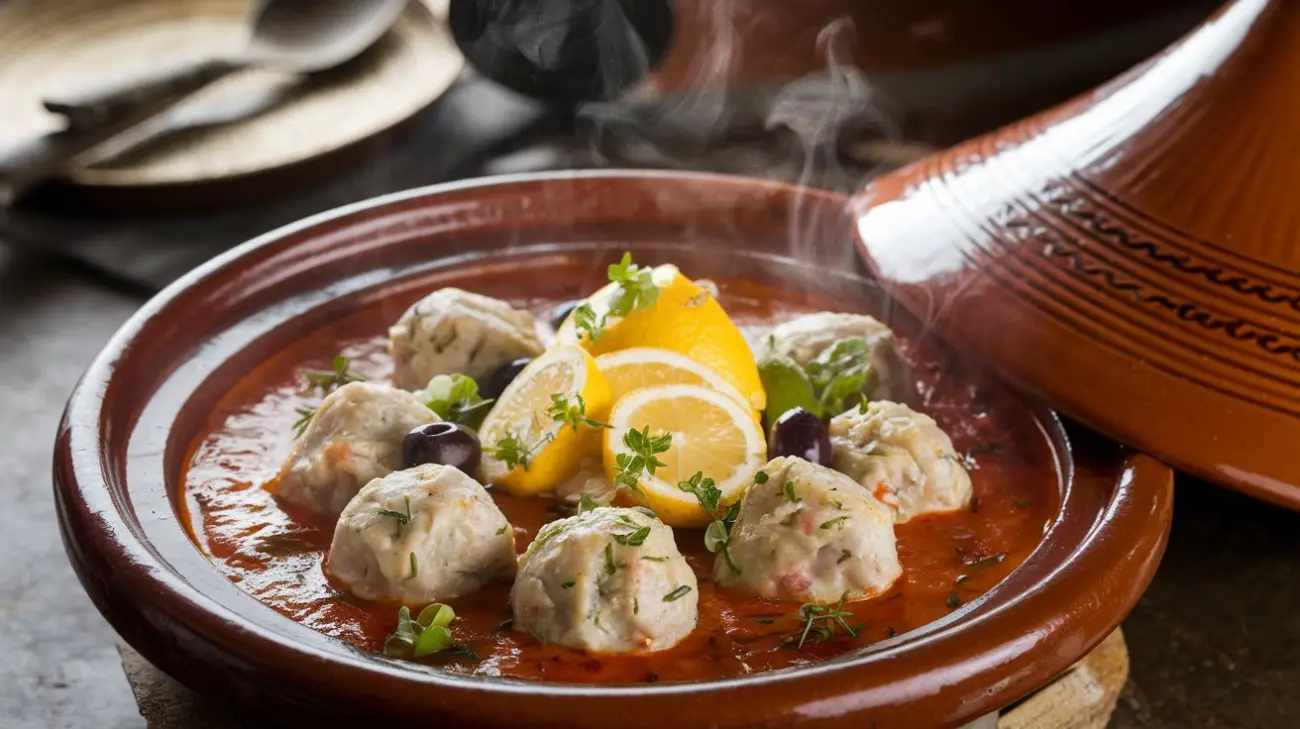Table of Contents
🐟 Dive into the World of Moroccan Fish Balls
Discover how fish balls become a soulful Moroccan dish when cooked in a tagine, a symbol of flavor, tradition, and family.
🌊 Brief Overview of Moroccan Cuisine and Its Coastal Flavors
Moroccan cuisine blends rich flavors, vibrant spices, and timeless techniques, reflecting the nation’s diverse heritage. Coastal regions shine with fresh seafood dishes infused with aromatic spices. Tagines, slow-cooked stews served in clay pots, epitomize this culinary art. The fish balls tagine perfectly captures the comforting harmony of seafood and spices.
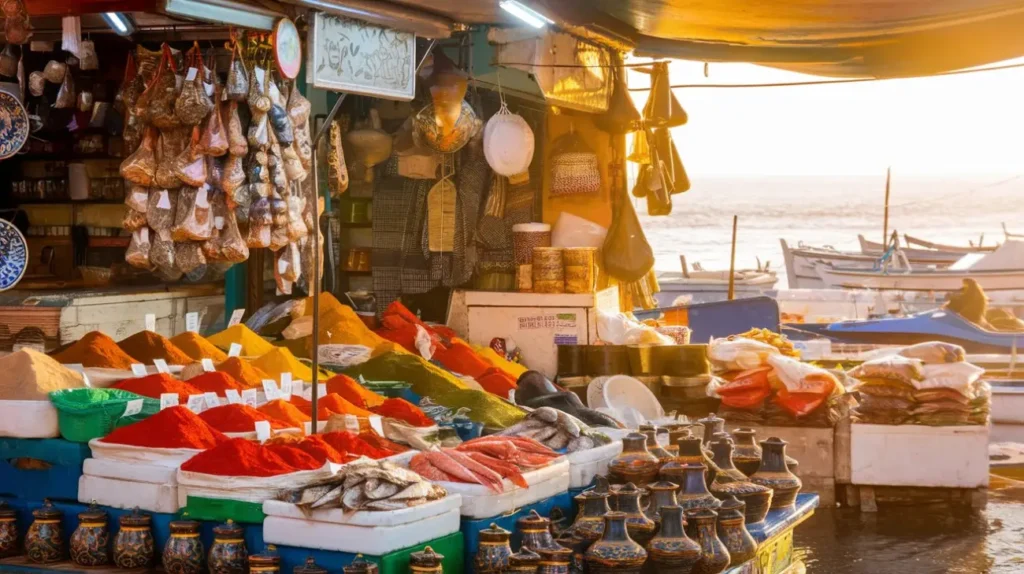
🍅 Why Fish Balls Tagine Is a Unique Dish That Warms the Heart
Fish balls tagine is not just a dish; it’s an experience that encapsulates the warmth of Moroccan hospitality. This recipe combines tender, spiced fish balls with a robust tomato-based sauce infused with preserved lemons, olives, and traditional spices. The result is a comforting, heartwarming dish perfect for family gatherings or festive occasions. Its uniqueness lies in the balance of flavors, the tangy preserved lemons, briny olives, and aromatic spices complement the mild sweetness of the fish. Whether savoring it on a chilly evening or celebrating with loved ones, fish balls tagine brings people together through its soulful and satisfying taste.
👉 You may also love our flavorful Fish Tagine with Artichokes and Peas
🏺 The Role of Tagine Cooking in Preserving Traditional Moroccan Flavors
The traditional tagine pot is central to Morocco’s culinary heritage. Its conical shape circulates steam, blending flavors and enhancing the richness of dishes like fish balls tagine. This slow-cooking method preserves the fish’s essence while deepening the spices and sauce. For generations, it has been a cornerstone of Moroccan kitchens, offering an authenticity unmatched by modern cookware.
🌐 Learn more about the history and function of tagine pots in this Wikipedia article on Tagines
🧆 Understanding the Essence of Moroccan Fish Balls Tagine
More than just comfort food, fish balls tagine is a sensory and cultural journey through Morocco’s coastal kitchens.
🍲 What Makes Moroccan Fish Balls Tagine Special
Moroccan fish balls tagine is more than just a meal; it’s a dish that embodies the essence of Moroccan culinary artistry. What makes this tagine truly special is its ability to balance flavors and textures familiarly and exotically. The fish balls, crafted from fresh, flaky fish and seasoned with warm spices, offer a tender yet robust base. These are then simmered in a rich tomato-based sauce infused with preserved lemons, garlic, and fragrant herbs such as cilantro and parsley. Adding olives provides a delightful brininess that enhances the dish’s complexity.
Another defining characteristic of this tagine is its humble and luxurious ability. Whether served at a family dinner or a celebratory feast, the dish adapts to the occasion while consistently delivering a warm, comforting experience. The intricate interplay of flavors reflects Morocco’s diverse culinary traditions and the skilful use of spices to elevate simple ingredients into something extraordinary.
👉 Explore another Moroccan classic: Moroccan Hargma – A Rich & Flavorful Tagine Food
🕌 The Cultural Significance of Tagine Dishes in Morocco
Tagine dishes hold a revered place in Moroccan culture, symbolizing togetherness, hospitality, and the art of slow cooking. The term “tagine” refers to both the dish itself and the earthenware pot in which it is prepared. This cooking method dates back centuries and is deeply ingrained in Moroccan traditions, with families often passing down their favorite tagine recipes through generations.
Tagines are a centerpiece of Moroccan dining. They are often shared communally and eaten directly from the pot. Gathering around a tagine fosters a sense of connection, making every meal a shared experience. Fish balls tagine, in particular, celebrates the coastal roots of Moroccan cuisine while honoring the country’s emphasis on fresh, local ingredients. Its preparation is a ritual, reflecting the patience and care required to achieve perfection in the dish.
🌐 Learn more about Moroccan food culture and its symbolism on Wikipedia’s Moroccan Cuisine
🌊 The Influence of Coastal Moroccan Cuisine on This Recipe
Morocco’s extensive coastline, which stretches along the Atlantic Ocean and the Mediterranean Sea, plays a vital role in shaping its cuisine. Coastal towns such as Essaouira, Agadir, and Tangier are renowned for their seafood, often paired with bold spices and preserved ingredients to create unforgettable dishes. This influence is vividly evident in Moroccan fish balls tagine.
The use of fresh fish as the centerpiece of this recipe reflects the abundance of seafood available in these regions. Preserved lemons and olives, staples in Moroccan coastal cooking, enhance the dish with tangy, salty, and citrusy flavors. These ingredients preserve the fish’s freshness and pay homage to the techniques developed over centuries to maximise flavor and minimize waste.
Moreover, the spices used in the tagine, such as cumin, paprika, and turmeric, mirror the trade routes that brought these flavors to Morocco’s shores. The result is a dish that tells the story of Morocco’s coastal heritage, combining the sea’s bounty with the warmth and depth of its culinary traditions.
🧄 Essential Ingredients for Authentic Moroccan Fish Balls
Behind every flavorful Moroccan fish balls tagine lies a symphony of carefully chosen ingredients, fresh fish, bold spices, vibrant herbs, and rich sauce.
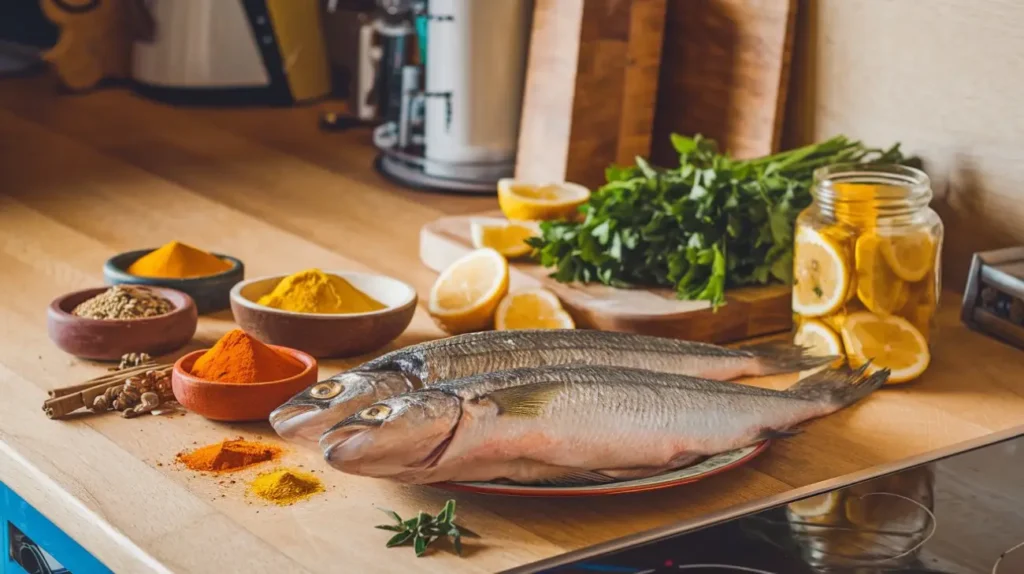
🐟 Selecting the Right Fish for Tender and Flavorful Balls
The foundation of any tremendous Moroccan fish balls tagine is the fish itself. Choosing the correct type of fish is crucial for achieving the desired texture and flavor. White fish such as cod, hake, or sea bass are ideal for their mild flavor and firm texture, which holds well when formed into balls. Freshness is key; opt for fish with a clean aroma and bright, clear eyes. Sourcing directly from a fish market ensures premium quality for those near coastal regions. After slow cooking, the right fish will absorb the spices beautifully while maintaining a tender bite.
🌐 Learn more about choosing fresh fish in this Seafood Watch guide to buying sustainable seafood.
🌶️ Must-Have Spices: Ras el Hanout, Cumin, Paprika, and Turmeric
Moroccan cuisine is synonymous with its vibrant use of spices, and fish balls tagine is no exception. Ras el hanout, a complex blend of spices often referred to as the “top of the shop,” adds depth and warmth to the dish. Cumin provides an earthy undertone, while paprika brings a mild sweetness with a hint of smokiness. Turmeric imparts a beautiful golden hue and enhances the overall flavor profile with its subtle bitterness. These spices combine to create a harmonious balance, making each bite an aromatic delight.
👉 Discover how these spices shape another dish in our Zesty Moroccan Meatballs Recipe
🍋 Key Additions: Preserved Lemons, Fresh Parsley, and Cilantro
Preserved lemons are a hallmark of Moroccan cuisine, contributing a tangy and slightly salty flavor that elevates the dish. Their distinctive taste complements the fish balls and sauce, tying the elements together. Fresh parsley and cilantro are essential for adding brightness and a herbal freshness to the mix. These herbs are often finely chopped, incorporated into the fish mixture and sprinkled as a garnish to enhance the aroma and visual appeal.
🍅 Tomato-Based Sauce: The Heart of Moroccan Seafood Tagines
The sauce is the soul of this dish, crafted from ripe tomatoes, garlic, and a touch of olive oil. Slow-cooked until it develops a rich and velvety consistency, the sauce is infused with the same spices used in the fish balls. Adding preserved lemons and olives amplifies the flavors, making it a luscious accompaniment that perfectly coats the fish balls. The sauce and fish balls create a harmonious blend of textures and tastes.
🎣 Preparing the Fish Balls Like a Moroccan Chef
Crafting Moroccan fish balls is an art that blends technique and tradition. This section reveals how to master both, just like local chefs do in Moroccan kitchens.
🌀 Steps to Grind and Mix the Fish with Herbs and Spices
Creating flavorful Moroccan fish balls begins with finely grinding the fish. Start by removing the skin and any visible bones from your chosen fish. Use a food processor to achieve a smooth, uniform texture, or mince the fish manually with a sharp knife for a more rustic feel. Once ground, mix the fish with finely chopped fresh parsley, cilantro, and a blend of essential Moroccan spices like cumin, paprika, turmeric, and Ras el Hanout. Adding minced garlic, a drizzle of olive oil, and a pinch of salt enhances the flavor. Knead the mixture gently but thoroughly to ensure the spices and herbs are evenly distributed. This step is crucial for building the bold flavors characteristic of Moroccan cuisine.
🧤 Techniques for Shaping Perfect Fish Balls
To shape the fish balls, moisten your hands with water or olive oil to prevent sticking. Scoop out small portions of the mixture, roughly the size of a walnut, and roll them gently between your palms until smooth. Consistency in size ensures even cooking, which is particularly important when preparing them in a tagine. If you aim for a professional touch, use a small scoop or measuring spoon for precise portions. Placing the shaped fish balls on a parchment-lined tray helps keep them intact and prevents sticking until you’re ready to cook.
🧂 Guidelines for Perfecting Texture and Consistency
Balancing moisture and binding is the key to the perfect fish ball texture. If the mixture feels too wet, a small number of breadcrumbs or a sprinkle of semolina can help bind it together without overpowering the delicate fish flavor. Conversely, if the mixture is too dry, adding a few drops of water or olive oil ensures a softer, more pliable texture. Avoid over-mixing, as this can lead to dense fish balls. For an added layer of flavor, let the prepared fish balls rest in the refrigerator for 20–30 minutes before cooking to allow the spices to meld and the mixture to firm up.
Following these steps and techniques, you’ll craft flavorful Moroccan fish balls with the ideal texture. They’ll pair beautifully with the rich, tomato-based tagine sauce.
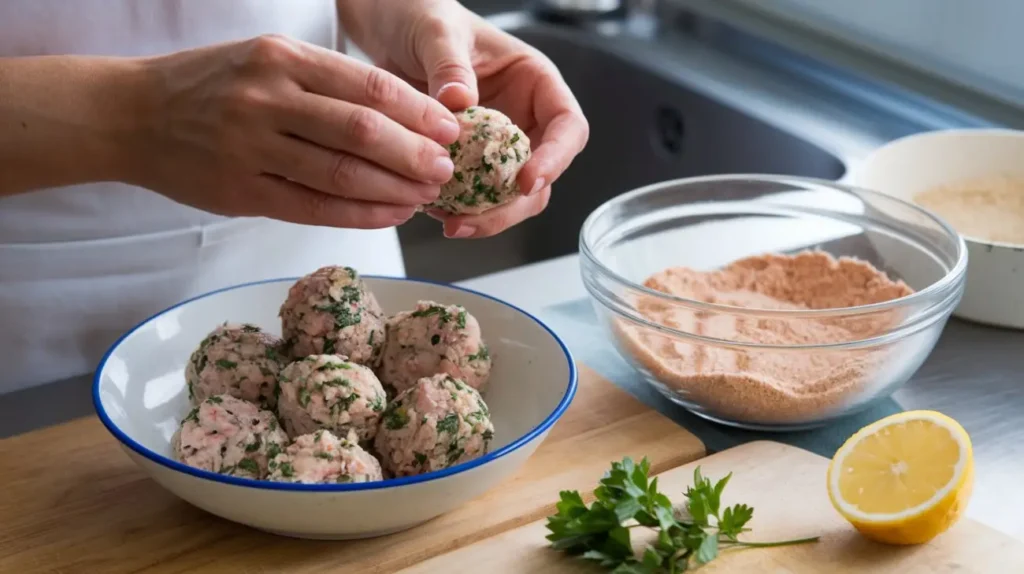
🍅 Crafting the Flavorsome Tagine Sauce
Creating a rich and flavorsome sauce is the heart of a successful tagine. This unique combination of ingredients and techniques brings together layers of flavor that make this dish a Moroccan masterpiece. Below, we break down the process into key steps to guide you in achieving the perfect sauce.
🧅 Preparing the Aromatic Base with Olive Oil and Onions
The foundation of a good tagine sauce begins with an aromatic base. Heat a generous drizzle of high-quality olive oil in your tagine or a deep pan over medium heat. Add finely chopped onions and sauté them until soft and translucent. This slow cooking releases the onions’ natural sweetness, forming a gentle, flavorful backdrop for the bold spices to come. Stir frequently to avoid browning, as the goal is to create a mellow, golden base.
🌶️ Adding Spices and Tomato Sauce for a Rich Flavor
Spices are the soul of tagine. Add a blend of ground cumin, coriander, turmeric, paprika, and a pinch of cinnamon to introduce warm, earthy flavours. Stir the spices into the onions, letting their fragrances bloom in the heat. Next, add a few tablespoons of tomato paste or puréed fresh tomatoes. This addition provides a rich, velvety texture and a subtle tanginess that enhances the dish’s complexity. Simmer the mixture for a few minutes to melt the flavors.
🍋 Incorporating Preserved Lemons and Olives for Authenticity
Add finely chopped preserved lemons and a handful of briny green or black olives for that unmistakable Moroccan flair. Preserved lemons bring a zesty, fermented depth, while olives introduce a savory, salty contrast that elevates the sauce. Stir these ingredients into the simmering mixture, allowing their flavors to infuse the sauce fully.
🌶️ Customizing the Spice Levels to Suit Your Palate
Taste your sauce at this stage and adjust the seasoning to suit your palate. Add a dash of cayenne pepper or chilli flakes if you prefer more heat. A hint of honey or a pinch of sugar can balance the flavors for a sweeter profile. Let the sauce simmer gently for a few minutes to integrate the adjustments before assembling the rest of the tagine.
Your carefully crafted sauce is ready to envelop your chosen ingredients, ensuring an intensely flavorful and aromatic tagine experience.
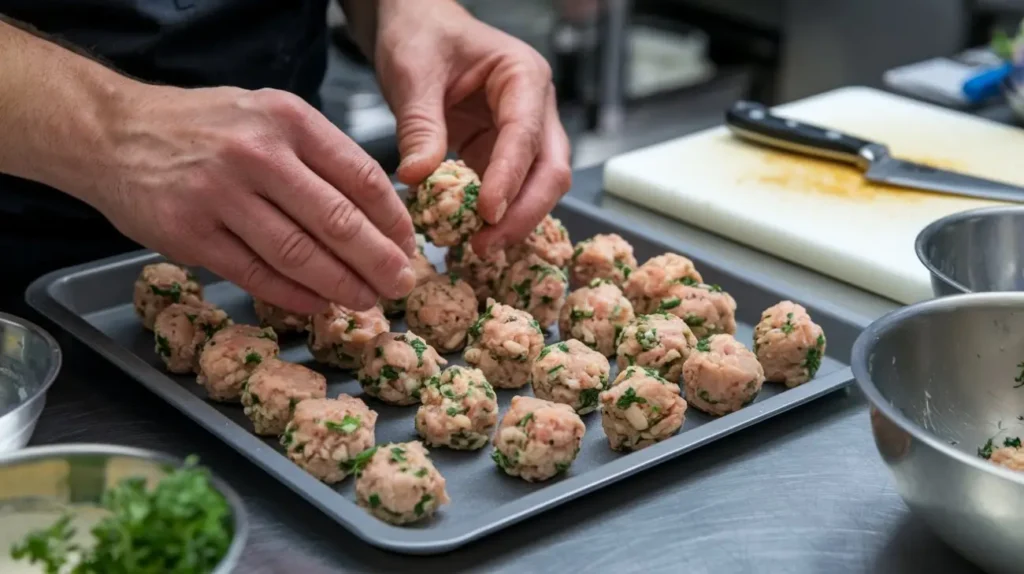
🏺 Mastering the Craft of Tagine Cooking
Mastering the art of tagine cooking is about embracing tradition, technique, and patience. This age-old Moroccan cooking style blends flavors and textures, resulting in a hearty and elegant dish. Here’s how to perfect your fish ball tagine, using a traditional pot or modern alternatives.
🔥 Benefits of Using a Traditional Tagine Pot
A traditional tagine pot isn’t just cookware; it’s an essential tool that enhances the dish’s flavor and texture. The unique conical lid traps steam, allowing the food to cook slowly in its juices, resulting in tender, moist fish balls and a concentrated, flavorful sauce. The clay or ceramic material ensures even heat distribution, creating a gentle cooking environment that prevents scorching. Beyond functionality, the tagine pot offers a cultural and visual charm, making it a centerpiece for serving and enjoying your meal.
🥘 Layering Fish Balls and Sauce for Even Cooking
Proper layering is key to achieving even cooking and harmonious flavors. Begin by spreading a portion of the sauce across the bottom of the tagine to create a protective layer. Arrange the fish balls in a single layer on top, ensuring each one is slightly nestled in the sauce. Pour the remaining sauce over the fish balls, ensuring they are evenly coated. This method allows the fish balls to cook uniformly, absorbing the spices and sauce while maintaining their shape and texture.
For another layering example, see Moroccan Fish Dishes: Stuffed Sardines Recipe
🕰️ How to Achieve Tender Fish Balls with Slow Cooking
The secret to tender, melt-in-your-mouth fish balls is slow cooking. Keep the heat low and steady, allowing the tagine to work its magic. The gentle simmering helps the fish balls stay moist while allowing the flavors to meld beautifully. Avoid frequent stirring, as the delicate fish balls may break apart. Patience is key, let the dish cook slowly until the fish balls are perfectly tender and infused with the sauce.
🔄 Alternative Methods If You Don’t Have a Tagine Pot
If you don’t own a traditional tagine pot, don’t fret! A heavy-bottomed Dutch oven or a deep skillet with a tight-fitting lid can achieve similar results. Cook on low heat to mimic the slow, steam-infused process. For a more authentic touch, place a piece of parchment paper under the lid to help trap moisture. These alternatives allow you to enjoy the essence of a tagine without compromising on flavor or texture.
Embracing these techniques will ensure your fish ball tagine is a culinary success, whether you stick to tradition or adapt to modern tools.
🍽️ Serving and Garnishing Moroccan Fish Balls Tagine
The final touch in preparing a Moroccan fish ball tagine is how you serve and present it. Pairing it with traditional accompaniments, garnishing thoughtfully, and enhancing its visual appeal ensures your dish is both delicious and enticing.
🥖 Traditional Accompaniments: Bread, Couscous, or Rice
A Moroccan fish ball tagine shines brightest when paired with the right side dish. Traditional Moroccan bread, such as khobz, is a classic choice, perfect for scooping up the rich, flavorful sauce. Fluffy couscous offers a light yet satisfying base for a more substantial meal that complements the dish’s bold flavors. If you prefer something heartier, steamed rice provides a simple and versatile alternative, allowing the tagine’s sauce to soak in for extra flavor. Whichever you choose, these sides transform the tagine into a complete, well-rounded meal.
🌿 Garnishing Ideas: Fresh Herbs, Olives, and Lemon Wedges
Thoughtful garnishing elevates your tagine, adding layers of freshness, brightness, and visual appeal. Sprinkle chopped fresh herbs like cilantro or parsley over the dish for a burst of color and a touch of earthy flavor. Add a handful of briny green or black olives to intensify the Mediterranean profile. For a zesty finish, garnish with wedges of fresh lemon or thin slices of preserved lemon. The citrus brightens the dish and provides a refreshing counterbalance to the hearty sauce.These simple touches make your dish look, and taste, irresistible.
Learn more about the health benefits of fresh herbs and olives in this Nutrition.org.uk overview.
🎨 Presentation Tips for Maximum Appeal
Presentation matters as much as taste, mainly when serving a tagine. Use a traditional tagine pot or a decorative serving dish to highlight the dish’s authenticity. Arrange the fish balls neatly in the sauce, ensuring each one is visible and evenly coated. Scatter garnishes strategically for a vibrant and inviting look. For an extra touch, serve the tagine on a wooden or woven placemat to complement its rustic cultural charm. Finally, ensure the sides, bread, couscous, or rice, are served in separate bowls or platters for a visually balanced and appetizing spread.
With these thoughtful additions, your Moroccan fish ball tagine will taste spectacular and become a feast for the eyes and a celebration of culinary tradition.
✨ Tips for Customizing and Perfecting the Recipe
The beauty of a Moroccan fish ball tagine lies in its versatility. While the traditional recipe is a treasure, customizing it allows you to add personal flair or incorporate regional inspirations. Here’s how to elevate your dish while avoiding pitfalls and tailoring it to your taste.
Exploring Regional Variations with Additional Vegetables
Morocco’s regions often include various vegetables in their tagines, adding depth and texture to the dish. To enhance the heartiness of the tagine, consider incorporating ingredients like bell peppers, zucchini, carrots, or even artichokes. Layer the vegetables beneath or alongside the fish balls to allow them to soak up the flavorful sauce as they cook. These additions diversify the dish and make it more colorful and nutritionally balanced.
Adding a Unique Twist with Saffron or Dried Fruits
Add a pinch of saffron to infuse your tagine with a luxurious aroma. This golden spice lends a subtle yet unmistakable flavor that beautifully complements the fish and sauce. Incorporate dried fruits like raisins, apricots, or dates for sweetness and Moroccan authenticity. These additions create a delightful balance between savory and sweet, elevating complexity.
Common Mistakes to Avoid When Making Fish Balls Tagine
While making fish balls tagine is straightforward, a few common mistakes can detract from its success. Avoid overmixing the fish ball ingredients, leading to a dense texture. Similarly, cooking too high heat may cause the fish balls to fall apart or dry out. Ensure the sauce is well-balanced in flavor, too much salt, lemon, or spice can overwhelm the dish. Patience is key; let the tagine simmer to develop its complete flavor profile.
Encouragement to Experiment and Adapt to Personal Preferences
A tagine is as much about personal expression as it is about tradition. Feel free to experiment with spices, vegetables, and garnishes to suit your taste. Would you prefer it spicier? Add more chilli flakes or cayenne. Do you enjoy a more decadent sauce? Use more tomato paste or a splash of broth. The goal is to create a dish that reflects your unique culinary preferences while honoring its Moroccan roots.
With these tips, you can confidently customize and perfect your fish ball tagine, making it a signature dish in your repertoire.
❓ Frequently Asked Questions: Moroccan Fish Balls Tagine
Is it necessary to own a tagine pot for this recipe?
A: No, it’s not essential. If you don’t have a tagine, you can use a deep pan with a well-fitting lid. Just make sure to cook on low heat to replicate the gentle, slow-cooking process that defines tagine dishes.
What fish works best for shaping into balls?
A: Choose firm white fish like cod, sea bass, or hake. These types stay intact during cooking and absorb Moroccan spices well without falling apart.
Is it possible to make the fish balls ahead of time?
A: Absolutely. You can shape the fish balls a few hours before cooking and store them covered in the refrigerator. This resting time helps enhance the flavor and makes them easier to handle.
How should I store leftovers?
A: Once the dish has cooled completely, transfer it to an airtight container and place it in the freezer. For the best quality, try to enjoy it within a couple of months. When ready to eat, reheat slowly over low heat to maintain the softness of the fish balls.
What are the gluten-free adaptations for this recipe?
A: You can replace any binding breadcrumbs with gluten-free options like almond meal or cooked rice. Serve the tagine with naturally gluten-free sides like rice or gluten-free flatbread.
🧡 Embracing the Heart of Moroccan Cuisine
The Moroccan fish balls tagine is more than just a meal, it’s an invitation to explore Morocco’s heartwarming flavors, vibrant traditions, and culinary artistry. This dish truly celebrates spices, textures, and the magic of slow cooking, offering a comforting yet elegant dining experience.
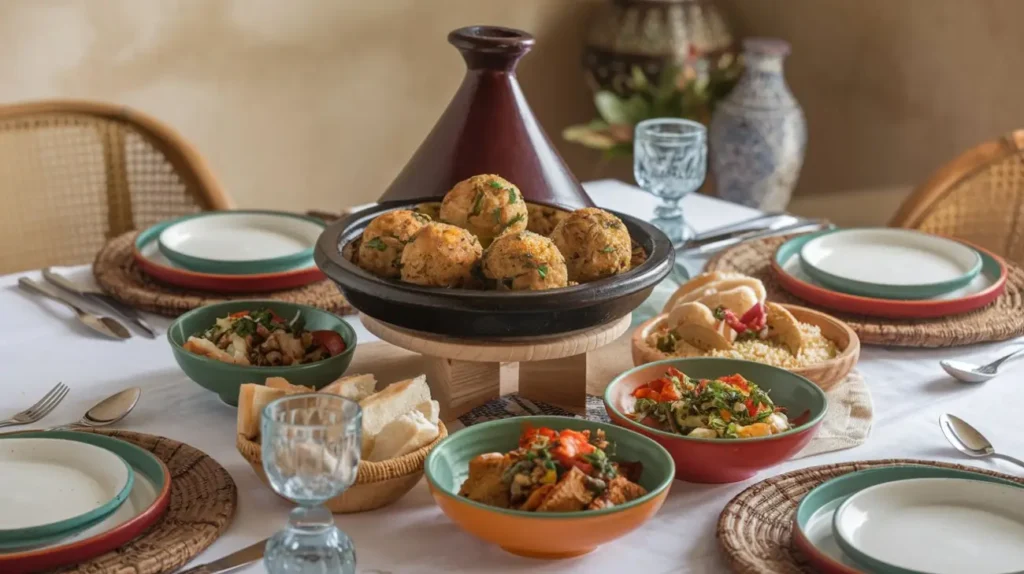
The Heartwarming Flavors of Moroccan Fish Balls Tagine
At its core, this dish is a beautiful harmony of flavors and aromas. The tender fish balls are infused with a rich blend of spices, while the sauce delivers layers of savory, tangy, and slightly zesty notes. Preserved lemons, olives, and fresh herbs ensure a well-rounded flavor profile that excites the palate. Every bite transports you to Morocco’s bustling markets and warm kitchens, where each ingredient tells a story of culture and tradition.
Try This Authentic Dish and Share Your Experience
Preparing Moroccan fish balls tagine at home is an adventure worth taking. Whether using a traditional tagine pot or a modern alternative, the process is as rewarding as the outcome. Dive into this authentic recipe, let your kitchen fill with the heady aromas of spices, and create a meal that brings loved ones together. Once you’ve tried it, share your experience with friends family, or on social media. Your take on this timeless dish might inspire others to embrace its flavors and create their version.
Highlight the Timeless Appeal of Moroccan Tagine Recipes
Moroccan tagine recipes have stood the test of time for good reason. Their versatility, depth of flavor, and ability to adapt to personal preferences make them a culinary treasure. Whether you’re savoring a traditional fish balls tagine or experimenting with regional variations, these recipes are a testament to the richness of Moroccan cuisine. They bridge the gap between the past and present, connecting us to the warmth of tradition while allowing room for creativity.
Embrace the timeless charm of Moroccan tagine recipes. Let this dish become a beloved staple in your kitchen, a flavorful reminder of the beauty of cultural culinary exploration.
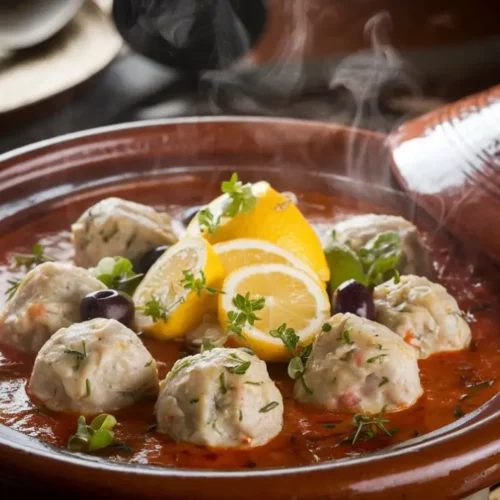
How to Create a Heartwarming Moroccan Fish Balls Tagine
Equipment
- 1 Tagine
Ingredients
- 500 g white fish fillets (e.g., cod, hake, or sea bass)
- 1/4 cup fresh parsley, finely chopped
- 1/4 cup fresh cilantro, finely chopped
- 2 cloves garlic, minced
- 1 tsp ground cumin
- 1 tsp paprika
- 1/2 tsp turmeric
- Salt and pepper, to taste
- 1 tbsp tbsp olive oil
- 1 tbsp breadcrumbs (optional, for binding)
For the sauce:
- 2 tbsp olive oil
- 1 medium onion, finely chopped
- 3 cloves garlic, minced
- 1 tsp ground cumin
- 1 tsp paprika
- 1/2 tsp turmeric
- 1/4 tsp cinnamon
- 2 cups fresh tomatoes, puréed or canned tomato sauce
- 1/4 cup water or fish stock
- 1 preserved lemon, finely chopped
- 1/2 cup green or black olives
- Salt and pepper, to taste
- Fresh parsley and cilantro, for garnish
Instructions
- Prepare the Fish Balls:
- Remove the skin and bones from the fish fillets. Finely grind the fish using a food processor or mince manually. (or buy the white fish fillet)
- Combine the fish with parsley, cilantro, garlic, cumin, paprika, turmeric, salt, pepper, and olive oil. Mix gently until well combined.
- Shape the mixture into walnut-sized balls. If needed, use breadcrumbs for binding. Refrigerate for 20–30 minutes to firm up.
Prepare the Sauce:
- Heat olive oil in a tagine or deep skillet over medium heat. Add the onions and sauté until soft and translucent.
- Stir in garlic, cumin, paprika, turmeric, and cinnamon. Cook until fragrant.
- Add the puréed tomatoes and water or fish stock. Simmer for 10 minutes until the sauce thickens slightly.
- Incorporate the preserved lemon and olives, stirring to combine.
Cook the Tagine:
- Place the fish balls in the sauce, ensuring they are evenly coated. Cover with the tagine lid or a tight-fitting pot lid.
- Simmer on low heat for 30–40 minutes, occasionally spooning the sauce over the fish balls. Avoid stirring to keep the fish balls intact.
Serve:
- Garnish with fresh parsley and cilantro. Serve hot with Moroccan bread, couscous, or steamed rice.
Notes
- For a unique twist, add a pinch of saffron or a handful of dried fruits like raisins or apricots to the sauce.
- If you don’t have a tagine pot, use a heavy-bottomed Dutch oven or skillet with a tight-fitting lid.
- Adjust spi
🥄 Nutritional Information (Per Serving)
| Nutrient | Approximate Amount |
|---|---|
| Calories | 320 kcal |
| Protein | 24 g |
| Fat | 18 g |
| – Saturated Fat | 3.5 g |
| Carbohydrates | 12 g |
| – Sugars | 4 g |
| Fiber | 3 g |
| Sodium | 680 mg |
| Cholesterol | 65 mg |
| Vitamin C | 22% DV |
| Iron | 15% DV |
| Omega-3 Fatty Acids | Moderate |
🔸 DV = Daily Value, based on a 2,000-calorie diet.
🔸 Values may vary depending on the type of fish and ingredients use
📲 Stay Connected with Moroccan Flavors!
Love this recipe? There’s more waiting for you! Follow us on social media for daily inspiration, new tagine recipes, behind-the-scenes tips, and a taste of Morocco delivered straight to your feed. Join our growing community of food lovers and share your own tagine creations, we’d love to see them!
👉 Follow us on Instagram, Facebook, and Pinterest: @tajinerecipes
📨 Join Our Flavorful Journey!
If you enjoyed this recipe, don’t miss out on our weekly newsletter! Get exclusive Moroccan tagine recipes, cooking tips, and cultural insights delivered straight to your inbox. Whether you’re a seasoned cook or just starting your culinary journey, there’s something delicious waiting for you every week.
👉 Subscribe now and let the magic of Morocco inspire your kitchen!
📩 Join Our Moroccan Foodie Community
Get the best Moroccan tagine recipes and seasonal culinary tips straight to your inbox.
Clarifying Essential Terms and Ingredients
To help you better understand the ingredients and elements mentioned in this article, here are brief explanations of key terms commonly used in Moroccan cuisine:
Khobz
This traditional Moroccan bread is a round, flat loaf with a dense yet soft texture. Used to scoop up tagines, stews, and dips, khobz is a staple in every Moroccan household. Made with simple ingredients like flour, water, salt, and yeast, it embodies the communal and cultural traditions of Morocco.
Ras el Hanout
A hallmark of Moroccan spice blends, “Ras el Hanout” translates to “head of the shop,” representing the finest spices a merchant can offer. This versatile blend typically includes a mix of warming spices such as cinnamon, cumin, turmeric, and ginger, and is used to flavor iconic dishes like tagines and couscous.
Saffron
Revered as “the golden spice,” saffron is obtained from the fine, hand-harvested threads of the crocus flower, making it a rare and precious addition to any dish. It imparts a rich yellow color and a subtle, earthy aroma to Moroccan dishes, from tagines to desserts. Its labor-intensive harvesting process makes it one of the most valuable spices in the world.
💬 We’d Love to Hear from You!
Tried this Moroccan fish balls tagine at home? Let us know how it turned out! Share your tips, twists, or questions in the comments below, your feedback helps us grow and inspires other readers to try the recipe too. We read every message and love hearing from you!
